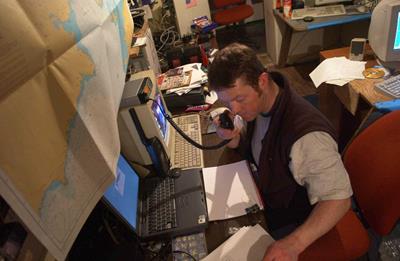Icom & Phoenix Data Systems support British Ice Challenger Expedition
Over a year ago the I-Track vehicle management system was launched as an effective GPS/radio communication solution allowing any organisation to manage its vehicle fleet efficiently and effectively. However no one at Icom realised that, 9 months later, the system would be given its toughest test. Steve Brooks and Graham Stratford formed the British Ice Challenge Expedition to drive the 56 miles over land from America to Russia. Using one of the most futuristic craft, Snowbird 6, they covered 24 miles only to be prevented from completing their mission by political bureaucracy. In the end they had to content themselves with putting their toe over the Russian border.
The story started for Icom only one month before the expedition was to leave. Steve Mulka, Engineering Manger of Phoenix Data Radio approached Icom's Marketing Manager Ian Lockyer about the possibility of supplying communication equipment that would stand up to freezing conditions and operate effectively and continuously over the duration of the expedition. GPS tracking would also be required, as safety for such a dangerous expedition was a vital factor. In addition, accurate tracking of Snowbird 6 by I-Track's GPS unit would be vital because of the potential political problems the expedition could encounter. I-Track seemed the perfect answer because it incorporates radio communications GPS tracking, text and status messages all in one easy to use package.
The expedition set off across the frozen Bering Strait from Cape Prince of Wales in Alaska on Friday, 5th April 2002. The journey is only possible in winter as it is the only time of the year when the Strait freezes over to become an ice bridge. Project manager and co-pilot Graham Stratford had originally planned to complete the entire route from Nome, Alaska, to Provodanya in about eight days.
After only 22 miles, at the international dateline, Russian authorities refused permission for the team to go any further. They threatened to arrest the pair, and take them off in Russian M18 army helicopters. The expedition looked to be in jeopardy until the explorers realised that they could still reach the Russian land mass of Big Diomedes, and prove it is possible to drive from America to Russia. Sunday 7th April 2002 was the day that the ice challenger expedition came to a triumphant end as Snowbird crossed the international dateline and drove into the record books as well as into forbidden territory. Snowbird 6 had become the first land based vehicle to cross the treacherous 24 miles of floating ice and open water that make up the Bering Strait from Wales, Alaska to the Russian land mass of the Big Diomedes.
An I-Track modified IC-F1610 VHF mobile transceiver was mounted in Snowbird 6 and another at base control. A VHF handheld was used on a safety helicopter. A repeater station powered by a petrol generator set 1930ft up a mountain allowed wider area communications coverage. Graham Stratford, Project manager said, 'the entire crossing took 50 hours and for that time the Icom equipment gave us crystal clear, continuous communication. '
Remarking on Phoenix's and Icom's help, Graham Stratford said,' What was outstanding was that Phoenix Data and Icom were only given two and a half weeks to set up our communications and they achieved this with outstanding results. Steve Mulka and David Hunter (Managing Director of Phoenix) were a great help, assisting us in many ways including programming of the radios and advising me on obtaining the right licences to operate the radios.
Remarking on why I-Track was chosen, Steve Mulka said,' there was strong consideration about the environment when choosing the radio system. Icom radios are very reliable and are essentially plug and play solutions. They worked very well in the field and the tracking of Snowbird 6 allowed the team to exactly pinpoint the vehicle's location.'The I-Track system runs on a standard PC. It displays vehicle position data and tracks movement history overlaid on a Microsoft land cartography display. I-Track keeps a historical database of vehicle data, giving the ability to review current and past vehicle movement and route activity for each vehicle. These data can be viewed as vehicle position tracks overlaid on a map or in tabular form using standard Windows data viewing tools. At the heart of I-Track is the Icom IC-F1610 VHF transceiver. This allows I-Track to communicate with its counterpart IC-F1610 & GPS unit installed in every vehicle in the fleet. The IC-F1610 is a fully programmable transceiver and allows I-Track to provide effective two-way radio communication. A large alphanumeric screen on the IC-F1610 further allows text messaging or status messaging.
Ian Lockyer, Marketing Manager at Icom (UK) Ltd said,' It is appropriate that in the Queen's golden jubilee year, a British Team created such a first. Such a feat, including all the problems with the Russian authorities, demonstrates the pioneering spirit that Scott, Bonnington, Feinnes and Hempleman-Adams have shown in the past. Icom were glad to be involved and show what an effective management tool I-Track is.'
Icom UK Marketing -
marketing@icomuk.co.uk
24/05/2002

